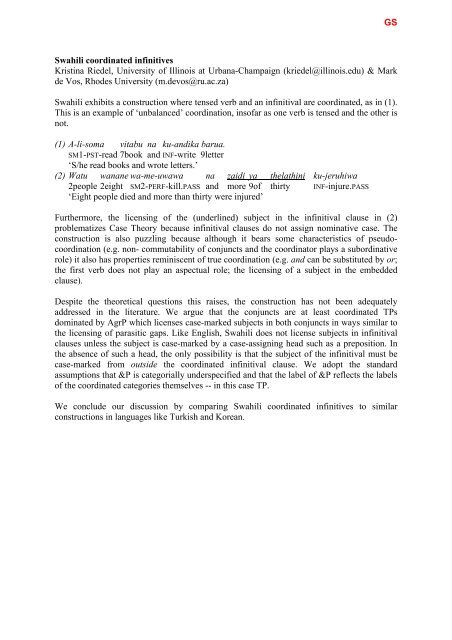here - 5th International Conference on Bantu Languages
here - 5th International Conference on Bantu Languages
here - 5th International Conference on Bantu Languages
Create successful ePaper yourself
Turn your PDF publications into a flip-book with our unique Google optimized e-Paper software.
Swahili coordinated infinitives<br />
Kristina Riedel, University of Illinois at Urbana-Champaign (kriedel@illinois.edu) & Mark<br />
de Vos, Rhodes University (m.devos@ru.ac.za)<br />
Swahili exhibits a c<strong>on</strong>structi<strong>on</strong> w<str<strong>on</strong>g>here</str<strong>on</strong>g> tensed verb and an infinitival are coordinated, as in (1).<br />
This is an example of ‘unbalanced’ coordinati<strong>on</strong>, insofar as <strong>on</strong>e verb is tensed and the other is<br />
not.<br />
(1) A-li-soma vitabu na ku-andika barua.<br />
SM1-PST-read 7book and INF-write 9letter<br />
‘S/he read books and wrote letters.’<br />
(2) Watu wanane wa-me-uwawa na zaidi ya thelathini ku-jeruhiwa<br />
2people 2eight SM2-PERF-kill.PASS and more 9of thirty INF-injure.PASS<br />
‘Eight people died and more than thirty were injured’<br />
Furthermore, the licensing of the (underlined) subject in the infinitival clause in (2)<br />
problematizes Case Theory because infinitival clauses do not assign nominative case. The<br />
c<strong>on</strong>structi<strong>on</strong> is also puzzling because although it bears some characteristics of pseudocoordinati<strong>on</strong><br />
(e.g. n<strong>on</strong>- commutability of c<strong>on</strong>juncts and the coordinator plays a subordinative<br />
role) it also has properties reminiscent of true coordinati<strong>on</strong> (e.g. and can be substituted by or;<br />
the first verb does not play an aspectual role; the licensing of a subject in the embedded<br />
clause).<br />
Despite the theoretical questi<strong>on</strong>s this raises, the c<strong>on</strong>structi<strong>on</strong> has not been adequately<br />
addressed in the literature. We argue that the c<strong>on</strong>juncts are at least coordinated TPs<br />
dominated by AgrP which licenses case-marked subjects in both c<strong>on</strong>juncts in ways similar to<br />
the licensing of parasitic gaps. Like English, Swahili does not license subjects in infinitival<br />
clauses unless the subject is case-marked by a case-assigning head such as a prepositi<strong>on</strong>. In<br />
the absence of such a head, the <strong>on</strong>ly possibility is that the subject of the infinitival must be<br />
case-marked from outside the coordinated infinitival clause. We adopt the standard<br />
assumpti<strong>on</strong>s that &P is categorially underspecified and that the label of &P reflects the labels<br />
of the coordinated categories themselves -- in this case TP.<br />
We c<strong>on</strong>clude our discussi<strong>on</strong> by comparing Swahili coordinated infinitives to similar<br />
c<strong>on</strong>structi<strong>on</strong>s in languages like Turkish and Korean.<br />
GS


